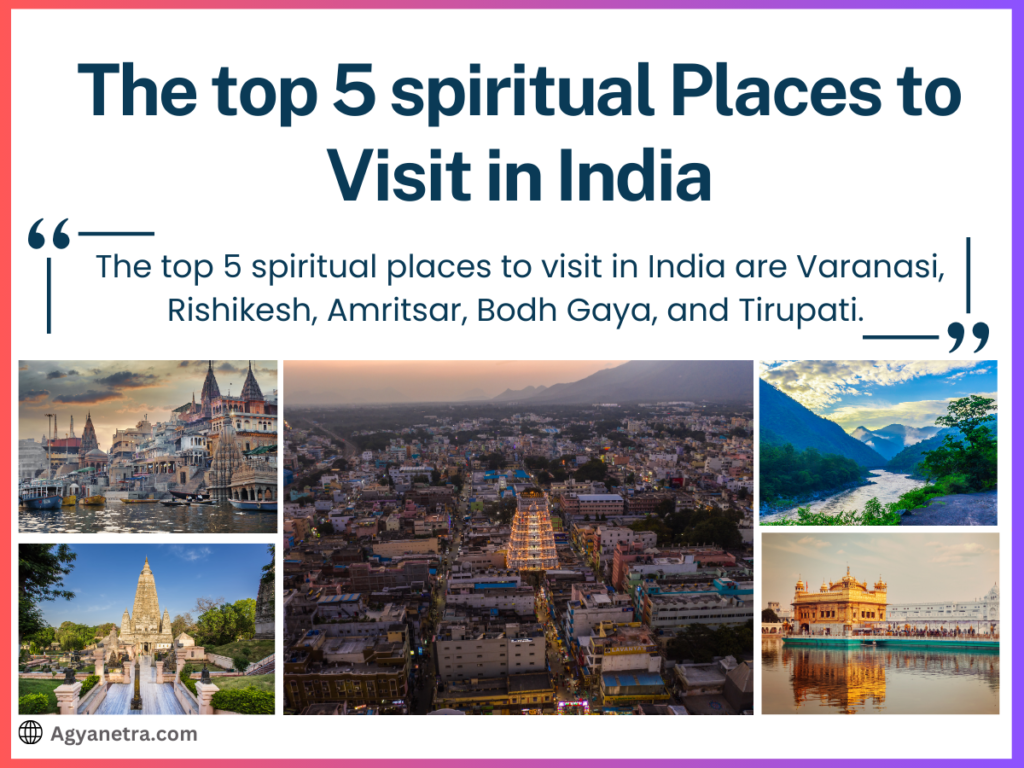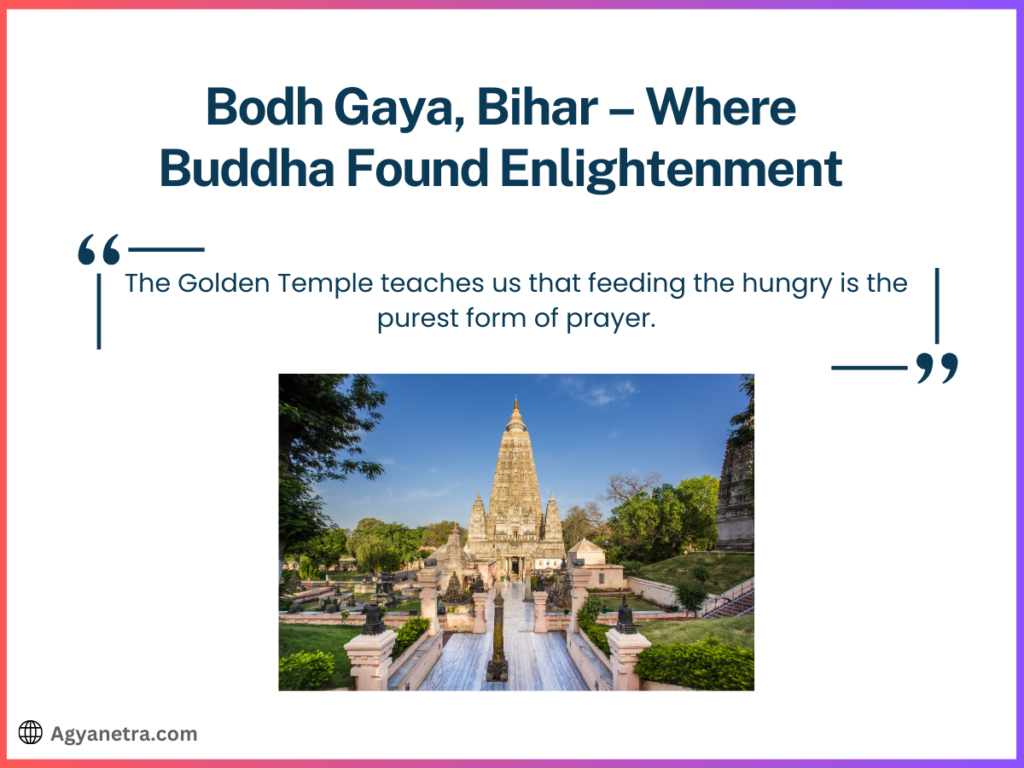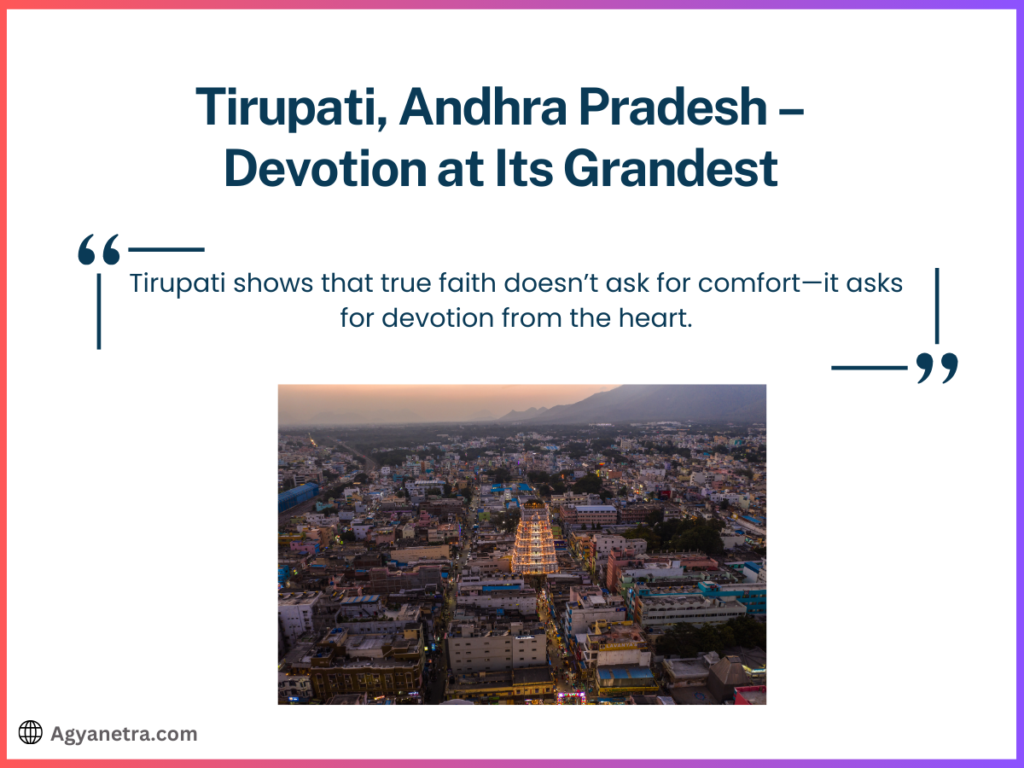5 Spiritual Places to Visit in India is not just a list—it’s a journey to the most peaceful and powerful spots in the country.
These are places where people go not only to pray but to feel calm, find answers, and connect with something deeper.
Ever wondered where you can sit by a holy river and feel your stress melt away? Or where you can walk into a golden temple and feel kindness all around you?
In this article, you’ll discover such magical places.
From ancient ghats to quiet forests, these spiritual destinations are full of stories, blessings, and life-changing energy.
Keep reading—you might just find the perfect place your heart has been looking for.
5 Spiritual Places to Visit in India (2025)
India is a land where spirituality blends beautifully with everyday life. It’s a country where people don’t just visit temples—they experience a deeper connection with the divine.

From ancient ghats along the Ganges to peaceful Himalayan retreats, India offers countless spiritual destinations.
Whether you’re looking for inner peace, blessings, or just curious about India’s sacred heritage, this guide will help you discover five of the most soul-stirring spiritual places in India.
These spiritual sites are not just for religious people—they attract travelers, yoga seekers, meditators, and those who want to understand India’s rich cultural and spiritual traditions.
These places offer more than rituals; they provide moments of calm, insight, and personal transformation.
Let’s explore five of the most powerful and peaceful spiritual destinations that every seeker must visit in India.
1. Varanasi, Uttar Pradesh – The Spiritual Heart of India
When you think of Indian spirituality, Varanasi is often the first place that comes to mind.
Known as one of the world’s oldest continuously inhabited cities, Varanasi (also called Kashi or Benares) sits on the sacred Ganges River and holds a special place in Hinduism.

This city is believed to be the home of Lord Shiva and is considered one of the holiest cities in India.
Devotees believe that dying in Varanasi and being cremated at the ghats brings liberation from the cycle of birth and death—called moksha.
Key Experiences in Varanasi:
Kashi Vishwanath Temple: One of the most important Shiva temples in India. People from all over come here to seek blessings and peace.
Ganga Aarti at Dashashwamedh Ghat: Every evening, priests perform a breathtaking ritual with fire lamps, chants, and music. It’s a spiritual moment that leaves everyone touched, whether religious or not.
Manikarnika Ghat: This cremation ground may seem intense, but it’s deeply symbolic. It represents the eternal cycle of life and death and offers a moment for self-reflection.
Example: Many travelers find themselves sitting quietly at the ghats at sunrise, simply watching the river and absorbing the energy. It’s a place where silence speaks volumes.
2. Rishikesh, Uttarakhand – Yoga and Peace by the Ganges
Rishikesh is a peaceful town at the foothills of the Himalayas, where the Ganges flows fresh and pure. It’s known globally as the “Yoga Capital of the World” and is a favorite for spiritual retreats and meditation programs.

If you’re looking for spiritual healing, a connection with nature, or a peaceful place to practice yoga, Rishikesh is perfect.
It’s also where The Beatles stayed in the 1960s to learn meditation from Maharishi Mahesh Yogi, bringing global attention to this sacred town.
Key Experiences in Rishikesh:
Parmarth Niketan Ashram: A calm space for yoga, spiritual talks, and wellness. People of all ages come here to recharge their body and mind.
Triveni Ghat Aarti: Just like in Varanasi, the Ganga Aarti here is soulful and filled with devotion. Watching the lamps float down the river under the evening sky is unforgettable.
Neelkanth Mahadev Temple: Located in the surrounding forest, this temple dedicated to Lord Shiva is a peaceful and scenic spot. Many hike up just to enjoy the silence and divine atmosphere.
Example: Visitors often start their day with yoga by the riverside, followed by a dip in the holy Ganges, and end it with the evening aarti. It’s a spiritual rhythm that brings deep peace.
3. Amritsar, Punjab – Golden Reflections of Faith
Amritsar is the spiritual center of Sikhism and home to the stunning Golden Temple, also known as Harmandir Sahib.

Surrounded by a sacred lake and covered in gold, this temple is open to everyone—regardless of religion, background, or belief.
This city offers a beautiful example of community service, unity, and spiritual strength. It shows how kindness and devotion can bring people together.
Key Experiences in Amritsar:
Golden Temple: A peaceful space that runs a massive community kitchen (langar), serving free meals to thousands daily. It’s a humbling experience to see people from all walks of life eating together.
Akal Takht: Right next to the temple, this is a seat of spiritual and political authority in Sikhism. It symbolizes strength and justice.
Dukh Bhanjani Ber Tree: Inside the temple complex, this old tree is believed to have healing powers. People sit nearby and pray for relief from suffering.
Example: Many visitors volunteer in the temple kitchen or help clean the premises, which adds a meaningful layer to their visit. It’s not just about seeing—it’s about participating.
4. Bodh Gaya, Bihar – Where Buddha Found Enlightenment
Bodh Gaya is one of the most important Buddhist pilgrimage destinations in the world. It’s where Siddhartha Gautama meditated under a Bodhi Tree and attained enlightenment, becoming the Buddha.

The atmosphere here is calm and meditative. People from around the world visit to walk the path of the Buddha, meditate in silence, and absorb the peaceful energy of the place.
Key Experiences in Bodh Gaya:
Mahabodhi Temple: A UNESCO World Heritage Site, this is the exact spot where Buddha reached enlightenment. The temple’s simplicity and history create a deep sense of calm.
Bodhi Tree: A direct descendant of the original tree still stands here. Many people sit in silence beneath it, seeking wisdom and peace.
Great Buddha Statue: A large and serene statue that inspires quiet reflection. It’s a peaceful spot for anyone needing a mental break from life’s chaos.
Example: You’ll often see monks and travelers alike meditating under trees or chanting softly. Even spending just one day here can reset your mind and bring unexpected clarity.
More Posts Like This
- Top 5 Yoga Ashrams in Rishikesh for a Spiritual Retreat
- How the Himalayas Inspire Inner Peace and Enlightenment
- What Is the Significance of Pancha Bhutas in Hinduism
- What Are the 9 Emotions in Indian Culture (Navarasa)
5. Tirupati, Andhra Pradesh – Devotion at Its Grandest
Tirupati is one of the busiest pilgrimage destinations in the world. It’s home to the Sri Venkateswara Temple, dedicated to Lord Vishnu. People believe that praying here brings prosperity and divine blessings.

What makes Tirupati special is the deep devotion of the pilgrims. Many wait for hours just to get a glimpse of the idol. The atmosphere is charged with faith and emotion.
Key Experiences in Tirupati:
Sri Venkateswara Temple: Located on the Tirumala hills, this temple draws lakhs of devotees daily. The laddoo prasadam is world-famous and part of the spiritual experience.
Kapileswara Swamy Temple: A calm Shiva temple at the base of the hills, offering a peaceful retreat before or after the main temple visit.
Silathoranam: A rare natural rock arch with deep mythological importance. It’s a short visit but worth it for its beauty and significance.
Example: Families often take a vow or offer their hair as a symbol of humility and surrender. This personal act of devotion makes the experience deeply emotional and unforgettable.
Conclusion
Exploring these five spiritual places—Varanasi, Rishikesh, Amritsar, Bodh Gaya, and Tirupati—offers more than just sightseeing.
They are journeys into India’s deep spiritual roots, where ancient traditions and divine energy still flow freely.
Whether you’re a spiritual seeker, a curious traveler, or someone looking for peace, these places offer something special.
They allow you to experience India’s spiritual diversity through different religions like Hinduism, Buddhism, and Sikhism, and connect with practices like meditation, yoga, and devotion.
These spiritual destinations also provide insight into India’s timeless rituals, temple culture, sacred rivers, and healing energy.
From chanting on the ghats of Varanasi to meditating under the Bodhi Tree, each experience adds a layer of calm, clarity, and connection to your inner self.
So if you’re planning a spiritual journey, start with these 5 spiritual places to visit in India.
Let your journey through faith, culture, and serenity begin. Whether it’s spiritual tourism, meditation retreats, or visiting holy cities, India has a way of touching your soul—and leaving you with unforgettable memories.
FAQs
What are the top 5 spiritual places to visit in India?
The top 5 spiritual places to visit in India are Varanasi, Rishikesh, Amritsar, Bodh Gaya, and Tirupati. These sacred destinations offer a mix of religious importance, peace, and spiritual energy for seekers, travelers, and pilgrims alike.
Why is Varanasi considered the spiritual heart of India?
Varanasi is believed to be one of the oldest living cities and the holiest in Hinduism. Located on the banks of the Ganges, it’s known for the Kashi Vishwanath Temple, sacred ghats, and the Ganga Aarti that draws people seeking moksha and inner peace.
What makes Rishikesh a spiritual destination in India?
Rishikesh is called the Yoga Capital of the World. It attracts visitors with its ashrams, Ganga Aarti, peaceful riverbanks, and meditation retreats. It’s ideal for those looking for spiritual growth, yoga practice, and mental clarity.
What is special about the Golden Temple in Amritsar?
The Golden Temple, or Harmandir Sahib, is the holiest site in Sikhism. Known for its golden structure and spiritual calm, it offers free meals to everyone and promotes equality, peace, and devotion, making it a unique spiritual experience.
Why do Buddhists visit Bodh Gaya?
Bodh Gaya is the place where Gautama Buddha attained enlightenment under the Bodhi Tree. The Mahabodhi Temple and meditation sites here attract Buddhists from around the world for prayer, learning, and quiet reflection
What is the significance of Tirupati in Hinduism?
Tirupati is home to the Sri Venkateswara Temple, one of the most visited and richest temples in the world. Devotees believe visiting Tirupati brings blessings, prosperity, and spiritual merit. Its laddoo prasadam is also very popular.
Are these spiritual places in India suitable for foreign tourists?
Yes, all five spiritual places in India welcome tourists from around the world. They offer guided tours, comfortable stay options, and peaceful experiences like yoga, meditation, and local rituals that appeal to both locals and foreigners.
What is the best time to visit spiritual destinations in India?
October to March is the best time to visit spiritual places in India. The weather is pleasant, and many festivals take place during these months, giving you a chance to witness authentic rituals and celebrations.
Do these spiritual places offer meditation or yoga retreats?
Yes. Especially in Rishikesh and Bodh Gaya, you’ll find many yoga and meditation centers offering short-term and long-term retreats. These programs help visitors relax, reconnect with themselves, and experience the spiritual depth of India.

Vidushi Gupta is an accomplished writer and digital marketing expert with contributions to organizations like Miles Educomp and ICAI. She has authored nearly ten novels and worked as a Senior Content Writer and Digital Marketing Specialist at ESS Global and Shabd. Her Quora posts have amassed almost 20 million views, reflecting her belief in the transformative power of the written word.

